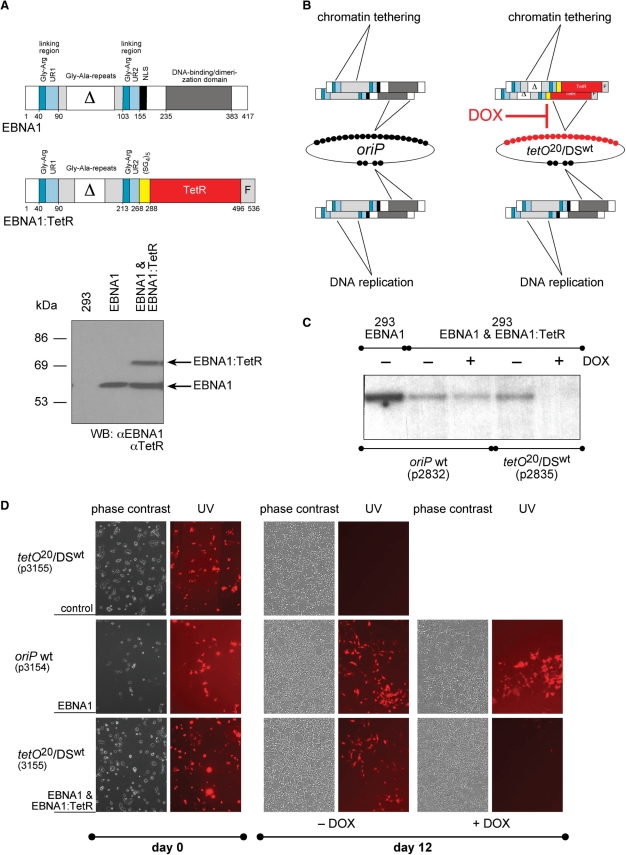Figure 1.
Chimeric EBNA1:TetR confers conditional plasmid maintenance. (A) Design of the trans-acting factor EBNA1:TetR. Wild-type EBNA1 with designated functional domains and their amino acid residues is shown in comparison with the chimeric protein EBNA1:TetR composed of EBNA1's amino-terminal half joined via an artificial linking domain [(SG4)5] to the complete coding region of the tetR gene followed by three repeats of the motif F, a minimal transcriptional activation domain (24). Most of the central glycine–alanin repeats (Gly-Ala-repeats) and about half of them are deleted in EBNA1 and EBNA1:TetR, respectively, as indicated (Δ) without functional consequences (48). Western blot analysis of the parental HEK293 cell line and its derivatives expressing EBNA1 (center lane) and EBNA1 + EBNA1:TetR (right lane) was performed with antibodies directed against TetR and EBNA1. (B) Schematic overview of the oriP replicon and the hybrid replicon plasmid tetO20/DSwt. The two cis-acting elements of oriP, FR and DS, carry 20 and 4 EBNA1-binding sites as indicated by the number of black circles. The hybrid replicon plasmid tetO20/DSwt carries an array of 20 tetO-binding sites (red circles) to which EBNA1:TetR binds with high affinity. EBNA1:TetR binds as a dimer-like EBNA1, thus these trans-acting factors are shown as doublets. (C) The plasmids p2832 (oriP wt) and p2835 (tetO20/DSwt) were separately transfected into HEK293 cells expressing EBNA1 and EBNA1:TetR. The cells were selected with puromycin with or without DOX (2.0 µg/ml) for 8 days. Low-molecular weight DNA was isolated, linearized and digested with DpnI to cleave unreplicated plasmid DNAs. Full-length DpnI-resistant plasmid DNA was detected by Southern blot hybridization with a radioactive probe specific for the prokaryotic plasmid backbone. DOX had almost no effect on p2832. No plasmid signal was detected when the cells had been transfected with p2835 and kept under selection in the presence of DOX. The left lane shows p2832 (oriP wt) in the HEK293 cell line expressing EBNA1, only. (D) HEK293 cells, which express no viral protein, EBNA1 or both EBNA1 + EBNA1:TetR were transfected with two different plasmids p3154 (oriP wt) or p3155 (tetO20/DSwt) encoding mRFP and puromycin resistance and selected for 4 days (day 0). The selective pressure was removed and the cells were kept with or without DOX (2.0 µg/ml) for a period of 12 days. No or only very few cells appeared to express mRFP in parental HEK293 cells transfected with the two plasmids at that time point (top row and data not shown) indicating that they were rapidly lost in the absence of EBNA1 and EBNA1:TetR. In EBNA1 expressing HEK293 cells transfected with p3154 (oriP wt), a fraction of cells expressed mRFP in the presence or absence of DOX (middle row) after 12 days. HEK293 cells expressing both trans-factors and transfected with p3155 (tetO20/DSwt) were mRFP positive, only, when the cells had been cultivated in the absence of DOX (bottom row).

